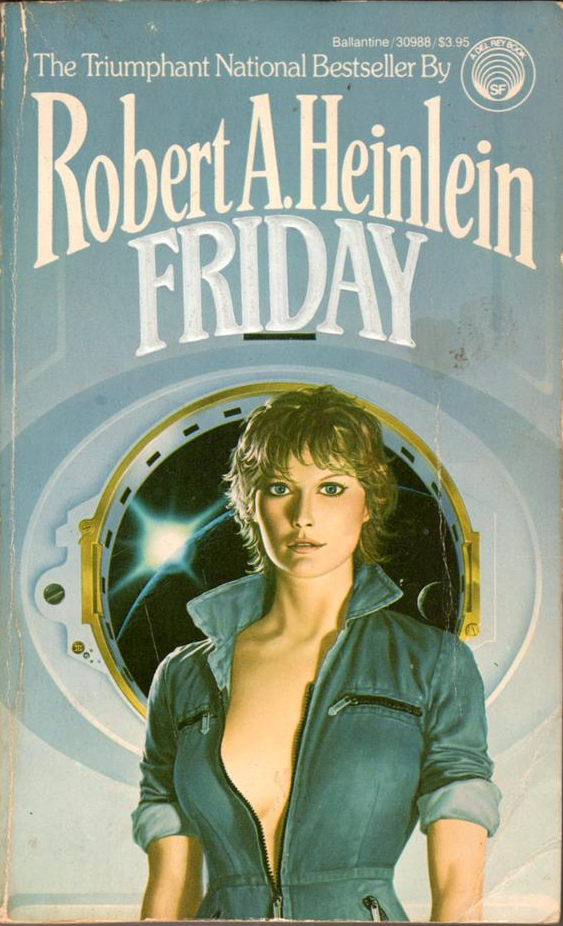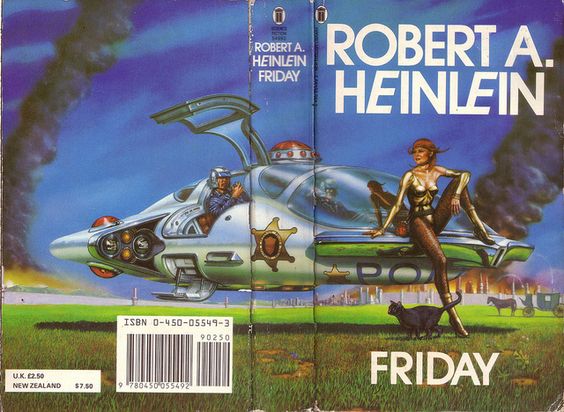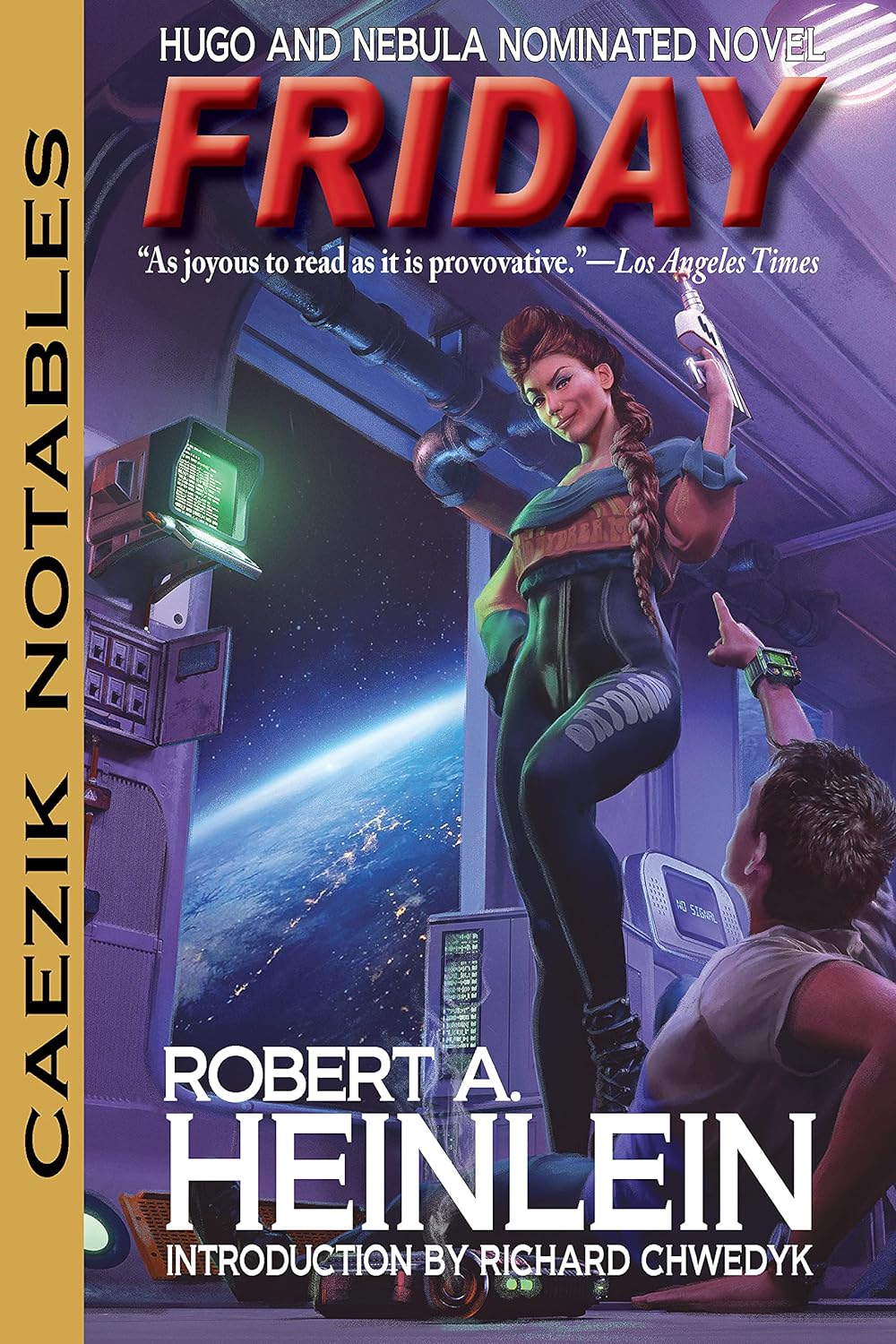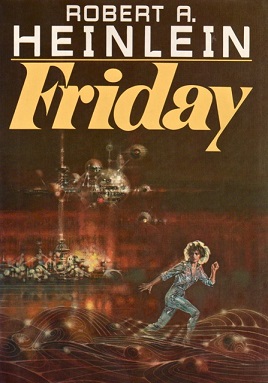SEMIOPUNK (14)
By:
March 1, 2024
An irregular, ongoing series of posts dedicated to surfacing examples (and predecessors) of the sf subgenre that HILOBROW was the first to name “semiopunk.”
THE GLASS BEAD GAME | FLATLAND | THE HAMPDENSHIRE WONDER | EXPLOITS AND OPINIONS OF DR. FAUSTROLL, PATAPHYSICIAN | A VOYAGE TO ARCTURUS | THE MAN WITH SIX SENSES | THE SPACE MERCHANTS | ODD JOHN | TIME OUT OF JOINT | THE SOFT MACHINE | SOLARIS | CAMP CONCENTRATION | CAT’S CRADLE | FRIDAY | BABEL-17 | RIDDLEY WALKER | ENGINE SUMMER | LE GARAGE HERMÉTIQUE | VALIS | RODERICK | PATTERN RECOGNITION | THE PLAYER OF GAMES | A CANTICLE FOR LEIBOWITZ | SNOW CRASH | VURT | FEERSUM ENDJINN | DOOM PATROL | THE THREE STIGMATA OF PALMER ELDRITCH | THE EINSTEIN INTERSECTION | LORD OF LIGHT | UBIK | GRAVITY’S RAINBOW | COSMONAUT KEEP | NINEFOX GAMBIT | THE MOUNTAIN IN THE SEA | BABEL | EMBASSYTOWN | WHITE NOISE | GLASSHOUSE | THE DIFFERENT GIRL.
FRIDAY
Heinlein’s fans were relieved to see the master return — after probably the worst book of his career, 1980’s The Number of the Beast — to kiss-kiss bang-bang form. (On the book jacket of the hardcover edition of Friday, Harlan Ellison exults, “Friday is Heinlein back in control.”) But despite plenty of of interesting/depressing (and sometimes accurate) predictions about the 21st century, it’s a deeply flawed book. Its plot might at best be described, generously, as a picaresque.
Sf author Jo Walton has called Friday “the worst book I love.” Also: “I can’t think of any book for which I have expended more energy trying to fix the end in my head.”
However, the novel’s titular protagonist is not only a kick-ass heroine — she’s a combat courier working for a quasi-military organization; a clone genetically engineered to be stronger, faster, and smarter than the rest of us — but a paragon of what the semiotician Peirce named “abductive” — which is to say intuitive, though by no means illogical — ratiocination. So I was wowed by Friday (the character, not the novel) as an adolescent sf fan; I remain to some extent in her debt even now.
Although Friday Jones is physically and mentally superior to ordinary people, she struggles with low self-esteem — because she’s forced to pass as an ordinary human in a society prejudiced against APs (Artificial Persons) like herself. APs have no citizenship, no heritage, no party loyalties. Friday is a book about passing, about what makes you human… which may perhaps make it highly relevant to many of today’s sf readers. On the other hand, there are some very skeevy and triggering aspects of the book, too — it’s a late Heinlein novel, after all — so consider yourself duly warned.
The story, to the extent that there is a story, is set in a balkanized future dominated by huge multinational corporations. At one point, a worldwide emergency — sabotage, assassinations — known as Red Thursday goes down. Friday eventually learns that Red Thursday is in fact the result of a struggle between rival factions within the ultra-powerful Shipstone corporation. America, too, is balkanized — into the California Confederacy, the Lone Star Republic, and the Chicago Imperium. As one character sums it up: “Pick one. A theocracy ruled by witchburners. Or a fascist socialism designed by retarded schoolboys. Or a crowd of hard-boiled pragmatists who favor shooting the horse that misses the hurdle.” Yikes. Why do I feel like this is all about to come true?
After several adventures, Friday ends up back at her agency — whose brilliant leader, known only as “Boss,” sees fit to retire from her active duty. Because she’s also… brilliant.
“I have unusual memory, unusual innate grasp of number and space and relationship, unusual skill at languages,” Friday says at one point. But her ratiocination skills don’t stop there. As Boss explains: “Not all couriers have your supreme talent for instantly integrating all factors and reaching a necessary conclusion.”
Beginning with Chapter 22, Friday is given various research assignments, which she carries out via an Internet-like system. (Which seems to feature only useful information — no crapola.) Heinlein depicts her capacity for making imaginative excogitations of hypotheses on the unknown causes of resulting facts — her skill as an “abductive” thinker — like so:
The silly questions speeded up. I found myself just getting acquainted with the details of Ming ceramics when a message showed up in my terminal saying that someone in staff wanted to know the relationships between men’s beards, women’s skirts, and the price of gold. […] But I had learned not to ignore questions merely because they were obvious nonsense; I tackled this one by calling up all the data I could, including punching out some most unlikely association chains. I then told the machine to tabulate all retrieved data by categories. Durned if I didn’t begin to find connections! As more data accumulated I found that the only way I could see all of it was to tell the computer to plot and display a three-dimensional graph — and that looked so promising that I told it to convert to holographic in color. Beautiful! I did not know why these three variables fitted together but they did. I spent the rest of that day changing scales, X versus Y versus Z in various combinations — magnifying, shrinking, rotating, looking for minor cycloid relations under the obvious gross ones… and noticed a shallow double sinusoidal hump that kept showing up as I rotated the holo — and suddenly, for no reason I can assign, I decided to subtract the double sunspot curve. Eureka! As precise and necessary as a Ming vase!
Now that she has developed a formula, Friday can proceed deductively: “I fiddled for most of a day, waiting, and proving to myself that I could retrieve a group picture from any year and, through looking only at male faces and female legs, make close guesses concerning the price of gold (falling or rising), the time of that picture relative to the double sunspot cycle, and — shortly and most surprising — whether the political structure was falling apart or consolidating.”
Friday also predicts the next major Black Death epidemic. When she asks Boss what her new job title is, he responds: “‘Job title’ indeed! Very well. You are staff intuitive analyst, reporting to me only. But the title carries an injunction: You are forbidden to discuss anything more serious than a card game with any member of the analytical section of the general staff.” The analysts are inductive and deductive types, one is led to assume. Boss doesn’t want Friday picking up any bad habits from them — or second-guessing herself.
Friday is a superhuman, and we can’t live up to her example. But there are aspects of our work as semioticians that can remind us of her approach. We too do archive dives, absorbing large amounts of stimulus. We too draw expertly and productively upon experiential, phenomenological knowledge — “the not wholly self-present or self-conscious knowledge of a body in the company of a self-reflexive mind capable of nurturing it,” as Wendy Wheeler puts it in The Whole Creature: Complexity, Biosemiotics and the Evolution of Culture . And at times, we too instantly integrate all factors and reach — what feels intuitively like — a “necessary” conclusion. Let’s just try to remain as aw-shucks humble and at the same time nerdily gleeful about our work as Friday is.
JOSH GLENN’S *BEST ADVENTURES* LISTS: BEST 250 ADVENTURES OF THE 20TH CENTURY | 100 BEST OUGHTS ADVENTURES | 100 BEST RADIUM AGE (PROTO-)SCI-FI ADVENTURES | 100 BEST TEENS ADVENTURES | 100 BEST TWENTIES ADVENTURES | 100 BEST THIRTIES ADVENTURES | 75 BEST GOLDEN AGE SCI-FI ADVENTURES | 100 BEST FORTIES ADVENTURES | 100 BEST FIFTIES ADVENTURES | 100 BEST SIXTIES ADVENTURES | 75 BEST NEW WAVE SCI FI ADVENTURES | 100 BEST SEVENTIES ADVENTURES | 100 BEST EIGHTIES ADVENTURES | 75 BEST DIAMOND AGE SCI-FI ADVENTURES | 100 BEST NINETIES ADVENTURES | 75 BEST HADRON AGE SCI-FI ADVENTURES.




